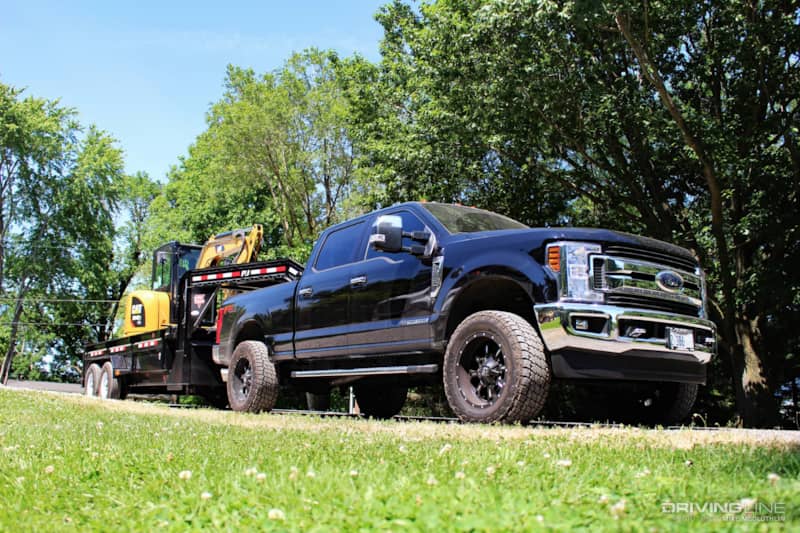Why You Need Load-Leveling Air Springs on Your SUV or Pickup Tow Rig
Load-leveling air springs are a useful modification for any truck or SUV owner looking to improve the towing and hauling performance of their rig. While it’s important to understand that air springs won’t increase your towing capacity or boost your gross vehicle weight rating, what they can offer is better control, more comfort, and additional safety under load.

Here’s a look at how air springs work, why a load-leveling setup will benefit your vehicle, and what to expect during the installation process.
Why Do I Need Load-Leveling Air Springs?
When towing with a heavy load it’s not uncommon for a vehicle’s rear suspension to start to sag, pulling down at the back of the truck and lifting up at the front. This is especially true when a hefty trailer tongue weight is factored into the equation. This isn’t just a cosmetic issue, as a load that isn’t properly supported at the rear has a number of negative effects on safety.

Specifically, this kind of excessive squat can raise headlights to a degree where they are no longer focused on the road ahead but instead pointed at the sky, reducing forward visibility at night. That same load that’s being taken off of the front wheels as the suspension lifts also reduces the efficacy of a truck or SUV’s braking system, putting extra stress on the rear brakes and creating longer stopping distances while reducing stability. Finally, with the rear end so low to the ground it’s not unusual to experience suspension or even the chassis bottoming out over bumps and rough pavement.

All of the above can also occur when carrying a heavy load inside a vehicle’s cargo area or on a roof rack—particularly if there’s already a full complement of passengers riding along.

Some owners respond to this kind of sag by adding an extra leaf or two to the rear suspension, installing a helper leaf spring, or by installing a set of heavy duty coil springs. Unfortunately, these solutions often negatively affect ride quality when the vehicle isn’t under load and can lead to bouncy handling and a noisy, rough character in every day driving. A helper leaf also only comes into play when the suspension is fully compressed, meaning the vehicle’s suspension geometry is already compromised.

Air springs offer a solution that is virtually transparent during the commute but performs just as well as a traditional spring when towing or hauling. Unlike a metal spring, they also offer the opportunity to individually level each side of a truck when a load’s weight can’t be evenly distributed.
How Do Load-Leveling Air Springs Work?
At its most basic, a load-leveling air spring is a rubber air bladder that mounts one of three ways. For trucks with leaf springs, it’s positioned in between the top of the leaf and the bottom (or side of each, depending on the mounting bracket) of the frame. For coil spring applications, the air bags can mount either inside the coil or outside the coil. Some spring designs also mount between the axle and the frame.

Each of these bags can be individually inflated to take on some of the load that is placed on the suspension, effectively increasing the spring rate. More pressure equals more support, raising up the level of the rear suspension to allow for better balancing front and back, as well as side to side. Not everyone needs individual left and right adjustments, and air springs can be installed using a T-line so that they can be adjusted simultaneously (making it quicker and easier to equalize the pressure on both sides).
How Hard Is It To Install Load-Leveling Air Spring Options?
Installing a set of load-leveling air springs isn’t all that complicated, but it can take about a day or so if you’re doing it for the first time, or don’t have access to a lift. There are universal kits available, as well as those designed for specific models, but if you go for the former option you’ll need to measure to make sure the spring will fit and mount properly in the space you have available.

Depending on your vehicle’s suspension design, installation requires you to lift the body, attach mounting brackets to the frame, assemble the air springs, attach brackets to the springs, and then attach the springs to the frame/axle/suspension installation points. You’ll also need to install and run the air lines to their fill point (with a Schrader inflation valve), or to the on-board compressor.

Keep in mind that if you’re using an in-coil spring, you might need to use a spring compressor to remove the factory setup. Always respect the energy stored within an automotive spring, as it can be dangerous if released unexpectedly. Most air bags can be installed by pushing the deflated bag through the gaps in the coil, with no need for removal.

The simplest load-leveling air spring kits can be inflated using an external compressor. This requires routing an air line to the a part of the SUV or truck—usually the hitch, or the trailer wiring plug—that is easy to access. You can either use a portable 12-volt compressor or a higher pressure line like you’d find at a service station to add air and pump up the ride height.

There’s also the option to install a self-contained system that includes an on-board compressor and potentially an air tank. The advantage of this setup is that you can air up and air down your helper springs at any time, which is useful for making adjustments on the go. Some setups allow for in-cab inflation and deflation, or even come with a wireless controller. The downside is that you’ll have to find a safe, protected space to mount the compressor and/or tank, and be comfortable with doing the extra wiring work required to provide it with power.

Most air springs require a certain amount of minimum inflation in order to ride comfortably. The pressure level can be found in the manual that came with the kit, and you should inflate the springs to this point prior to a test drive.
What Should I Expect To Pay For Load-Leveling Air Springs?
Load-leveling air springs can be an affordable mod to make. Most kits range from $300 to $600, depending on how elaborate the setup is, the suspension design, and the brand. There are also some very, very basic kits that come in under that amount, as well as more expensive options in the $1,000 to $2,000 range that include on-board compressors.











